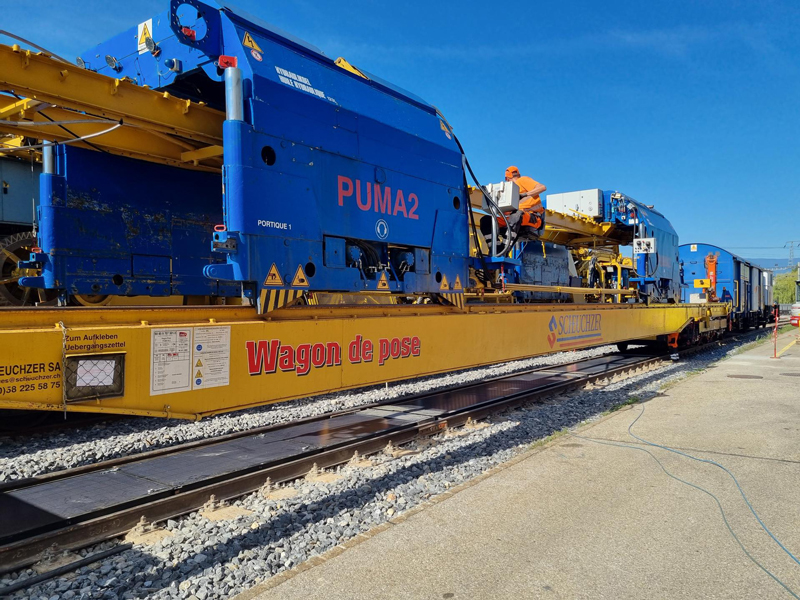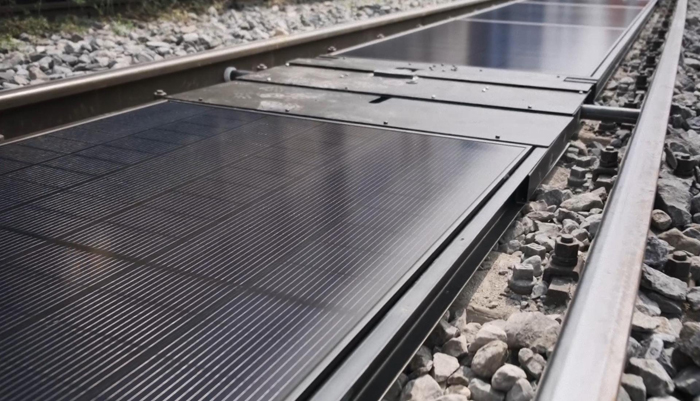Send this article to a friend:
October
11
2024
Send this article to a friend: October |
Solar power project hits the rails with between-track panel pilot
Despite many household and business rooftops rocking solar panels, and dedicated "farms" also soaking up the Sun's energy, there's still huge potential for harvesting much more. Sun-ways is looking to tap into the estimated 1-TWh annual energy potential from the 5,000-km of railroad tracks in Switzerland by laying removable PV panels between them. The company states that this could potentially meet the electricity needs of almost a third of the country's public transport sector, while making yearly CO2 savings of more than 200,000 tons.
Each "full black" panel measures 1 x 1.7 m (3.3 x 5.5 ft) and features an anti-reflective filter to prevent glare. This is mounted as a multi-array format in a frame where all components and wiring are housed within. The current setup is designed to fit track gauges of 1.43 m (4.6 ft), though this can be adapted for non-standard installations. The multi-panel modules can be installed and connected manually by engineers, but railway maintenance company Scheuchzer SA has developed a machine capable of installing up to 1,000 m2 of Sun-Ways panel arrays per day. 
The "solar power plant" has been designed so that the panel modules can be temporarily removed while railway engineers perform track maintenance, and then put back down when work has been completed. And the setup has been tested for stability for trains passing overhead at up to 150 km/h (93 mph), and can withstand 240-km/h (150 mph) winds. Since the panels are laid flat, snowfall during winter months will naturally adversely affect performance. But the company told us that cylindrical brushes could be attached to the ends of trains to deal with the inevitable accumulation of dirt – so it's not a huge leap to come up with something similar to clear snow. Electricity produced by the system could be used to power nearby infrastructure such as switches or points – or even stations. Of course it could be fed into the grid, or routed to "the traction energy network that powers locomotives" – which negates the need for ground-based inverters.  The self-contained panels can be connected to the grid, used to power local infrastructure or routed to "the traction energy network that powers locomotives"
Sun-Ways
An application to the Federal Office of Transport (FOT) last year was initially refused, but Sun-Ways labored on – engaging academics from the HEIG-VD (Haute Ecole d'Ingénierie et de Gestion du Canton de Vaud) to undertake independent assessments of custom-built panel prototypes. These were added to the technical and safety documentation produced by Geste Engineering, and the plan resubmitted for approval. It took 10 months of deliberation, but the FOT has now given the green light to a 2025 pilot on a 100-m (330-ft) stretch of the TransN line 221 near Buttes railway station in he Swiss canton of Neuchâtel. Some 48 panels will be installed between the rails, at a capacity of 18 kWp. The setup will be connected to the local grid by the electricity distributor Viteus and railway infrastructure outfit DG Rail, and pilot project trains will roll at 70 km/h. Installation and removal tests will be undertaken during the trial, together with more tests and measurements to "ensure that there will be no damaging impact on the railway infrastructure." Sun-Ways, from vision to reality
Sun-Ways has also announced that it will embark on a feasibility study on a 1,500-m (4,921-ft) section of private track in the municipality of Aigle, with an installed capacity of 288 kWp. The company is currently in the early stages of setting up another pilot with SNCF in France too, along with others in Spain, Romania and South Korea. Discussions with operators in China, Thailand, Australia and the US are also in the early stages. Source: Sun-Ways
While Paul is loath to reveal his age, he will admit to cutting his IT teeth on a TRS-80 (although he won't say which version). An obsessive fascination with computer technology blossomed from hobby into career before hopping over to France for 10 years, where he started work for New Atlas in 2009. Now back in his native Blighty, he serves as Managing Editor in Europe.
|
Send this article to a friend:
 |
 |
 |